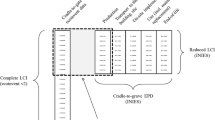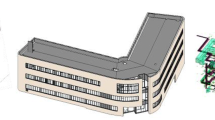Abstract
Purpose
In an effort to develop a whole building Life Cycle Assessment (LCA) tool, National Institute of Standards and Technology (NIST) is transforming new bottom-up Building for Environmental and Economic Sustainability (BEES) data into a hybrid database in which the strengths of both bottom-up and top-down approaches can be combined. The objective of this paper is to describe the framework and the process under which the hybrid BEES database is being built, with an emphasis on its accounting structure. This paper can support other efforts to build hybrid Life Cycle Inventory (LCI) databases.
Methods
The BEES hybridization utilizes the most detailed supply and use tables (SUTs)—known as item-level data—focusing particularly on the construction sectors. First, the partial SUTs at the item level are constructed and connected to standard SUTs that describe the rest of the economy, which is then followed by balancing and “redefinition.” Second, item-level environmental data are compiled and then also balanced and redefined, which completes the compilation of the bi-resolution SUTs with environmental data. Third, the bi-resolution SUTs are integrated with the BEES data that have been converted into matrix form. Because the completely rolled out BEES technology matrix involves a significant number of products, the integration prioritizes the product groups that are potentially the most significant contributors to the LCIA results for buildings.
Results
This step-by-step procedure will enable the creation of a hybridized BEES database, combining the strengths of both the bottom-up, process-based data and the top-down, input-output data with enhanced resolution. The benefit of hybridization at the database level—as opposed to at the individual LCA study level—is that whole-building LCA users can adopt the hybrid BEES approach, with its benefit of a more complete system definition, without the training or effort that would be required to construct a hybrid system from scratch. In addition, reformulation of new BEES data into a matrix structure better facilitates the parametric LCA application that is central to NIST’s vision to develop a tool for assessing the sustainability performance of energy technologies and systems in an integrated building design context.
Conclusions
There are currently a number of initiatives being organized to implement a hybrid approach at the LCI database level. In laying out the methodological framework for efficiently transforming an existing LCI database into a hybrid database, this paper can support future development of hybrid LCI databases.

Similar content being viewed by others
Notes
The term “rolled-out” LCI in this paper refers to the elementary data underlying an LCI that show the exchanges of intermediate products and direct emissions by unit processes (or sectors). It is generally represented as a set of matrices including the technology matrix and the direct environmental exchange matrix. Ecoinvent uses the term, “unit process raw data” instead. Similarly, the term, “rolled-up LCI” refers to calculated LCIs, for which Ecoinvent uses the term, “cumulated results.”
The term, “redefinition” is used by the Bureau of Economic Analysis (BEA) of the U.S. Department of Commerce to refer to the practice of manually moving certain outputs from a sector in a supply matrix and corresponding inputs to that sector in a use matrix to the industry where the output is produced as the primary product. It is done in an attempt to mimic the commodity–technology model without generating any negatives in the technology coefficient matrix (see Suh et al. 2010 and Horowitz and Planting 2006 for details).
References
Bright RM, Strømman AH, Hawkins TR (2010) Environmental assessment of wood-based biofuel production and consumption scenarios in Norway. J IndEcol 14:422–439
Chang Y, Ries RJ, Wang Y (2010) The embodied energy and environmental emissions of construction projects in China: an economic input–output LCA model. Energ Policy 38:6597–6603
Finnveden G, Hauschild MZ, Ekvall T, Guinée J, Heijungs R, Hellweg S, Koehler A, Pennington D, Suh S (2009) Recent developments in Life Cycle Assessment. J Environ Manage 91:1–21
Heijungs R (1994) A generic method for the identification of options for cleaner products. Ecol Econ 10:69–81
Heijungs R, Suh S (2002) The computational structure of life cycle assessment. Kluwer Academic Publishers, Dordrecht, The Netherlands
Hendrickson CT, Horvath A, Joshi S, Lave LB (1998) Economic input–output models for environmental life-cycle assessment. Environ Sci Technol 32:184A
Horowitz K, Planting M (2006) Concepts and methods of the input-output accounts. Bureau of Economic Analysis, Department of Commerce, Washington, DC, USA
ISO (1998) ISO 14041: Environmnetal management—life cycle assessment—goal and scope definition and inventory analysis. International Organization for Standardization, Geneva, Switzerland
ISO (2006) ISO 14044: Environmental management—life cycle assessment—requirements and guidelines. International Organization for Standardization, Geneva, Switzerland
Joshi S (1999) Product environmental life-cycle assessment using input-output techniques. J Ind Ecol 3:95–120
Kofoworola O, Gheewala S (2008) Environmental life cycle assessment of a commercial office building in Thailand. Int J Life Cycle Assess 13:498–511
Konijn P (1994) The make and use of commodities by industries. Ph.D. thesis, University of Twente, Enschede
Lave LB, Cobras-Flores E, Hendrickson C, McMichael F (1995) Using input–output analysis to estimate economy wide discharges. Environ Sci Technol 29:420–426
Lenzen M (2002) A guide for compiling inventories in hybrid life-cycle assessments: some Australian results. J Clean Prod 10:545–572
Lin C (2009) Hybrid input–output analysis of wastewater treatment and environmental impacts: a case study for the Tokyo Metropolis. Ecol Econ 68:2096–2105
Lippiatt B (2010) Building for environmental and economic sustainability online. NIST, Washington, DC
Marheineke T, Friedrich R, Krewitt W (1998) Application of a hybrid-approach to the Life Cycle Inventory Analysis of a Freight Transport Task. In: SAE 1998 Transactions—Journal of Passenger Cars, Section 6 Volume 107. Society of Automotive Engineers (SAE), Warrendale, PA
Matthews HS, Small MJ (2000) Extending the boundaries of life-cycle assessment through environmental economic input–output models. J Ind Ecol 4:7–10
Moriguchi Y, Kondo Y, Shimizu H (1993) Analyzing the life cycle impact of cars: the case of CO2. Ind Environ 16:42–45
Nakamura S, Kondo Y (2002) Input–output analysis of waste management. J Ind Ecol 6:39–64
Peters G, Hertwich E (2006) A comment on “Functions, commodities and environmental impacts in an ecological-economic model”. Ecol Econ 59:1–6
Peters G, Wiedmann S, Rowley H, Tucker R (2010a) Accounting for water use in Australian red meat production. Int J Life Cycle Assess 15:311–320
Peters G, Rowley H, Wiedmann S, Tucker R, Short MD, Schulz M (2010b) Red meat production in Australia: life cycle assessment and comparison with overseas studies. Environ Sci Technol 44:1327–1332
Reich-Weiser C, Ace F, Brooks C, Suh S (2010) An iterative hybrid carbon footprint. In: Murray J, Wood R (eds) In: The sustainability practitioner’s guide to input–output analysis. Common Ground Publishing, Urbana-Champaign
Sharrard AL, Matthews HS, Ries RJ (2008) Estimating construction project environmental effects using an input-output-based hybrid life-cycle assessment model. J Infrastruct Syst 14:327–336
Stone R, Bacharach M, Bates J (1963) Input–output relationships, 1951–1966, programme for growth, vol 3. Chapman & Hall, London
Strømman A, Peters G, Hertwich E (2009) Approaches to correct for double counting in tiered hybrid life cycle inventories. J Clean Prod 17:248–254
Suh S (2004) Functions, commodities and environmental impacts in an ecological-economic model. Ecol Econ 48:451–467
Suh S (2005) Developing sectoral environmental database for input-output analysis: comprehensive environmental data archive of the U.S. Econ Syst Res 17:449–469
Suh S (2006) Reply: downstream cut-offs in integrated hybrid life cycle assessment. Eco Econ 59:7–12
Suh S (ed) (2009) Handbook of input–output economics in industrial ecology. Springer, New York
Suh S (2010) Comprehensive environmental data archive (CEDA). In: Murray J, Wood R (eds) The sustainability practitioner’s guide to input–output analysis. Common Ground Publishing, Urbana-Champaign
Suh S, Huppes G (2002) Missing inventory estimation tool using extended input-output analysis. Int J Life Cycle Assess 7:134–140
Suh S, Huppes G (2005) Methods for life cycle inventory of a product. J Clean Prod 13:687–697
Suh S, Lenzen M, Treloar G, Hondo H, Horvath A, Huppes G, Jolliet O, Klann U, Krewitt W, Moriguchi Y (2004) System boundary selection in life-cycle inventories using hybrid approaches. Environ Sci Technol 38:657–664
Suh S, Weidema B, Schmidt J, Heijungs R (2010) Generalized make and use framework for allocation in LCA. J Ind Ecol 14:335–353
Treloar G (1997) Extracting embodied energy paths from input–output tables: towards an input–output-based hybrid energy analysis method. Econ Syst Res 9:375–391
Weidema B (2011) Steps toward a global hybrid database, International Society for Industrial Ecology (ISIE) meeting, Berkeley, CA
Wiedmann TO, Suh S, Feng K, Lenzen M, Acquaye A, Scott K, Barrett JR (2011) Application of hybrid life cycle approaches to emerging energy technologies—the case of wind power in the UK. Environ Sci Technol 45(13):5900–5907
Author information
Authors and Affiliations
Corresponding author
Additional information
Responsible editor: Shinichiro Nakamura
Rights and permissions
About this article
Cite this article
Suh, S., Lippiatt, B.C. Framework for hybrid life cycle inventory databases: a case study on the Building for Environmental and Economic Sustainability (BEES) database. Int J Life Cycle Assess 17, 604–612 (2012). https://doi.org/10.1007/s11367-012-0393-z
Received:
Accepted:
Published:
Issue Date:
DOI: https://doi.org/10.1007/s11367-012-0393-z




